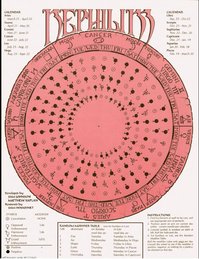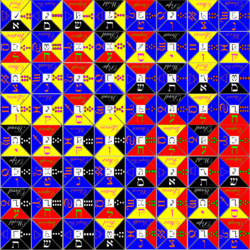A magic system is the sum total of its mechanics, interface, visual art, audio, narrative, and mythology, because a game is defined by its experience and experience consists in all of these components. Since a magic system simulates the alteration of reality by the will through the agency of metaphysical forces, all of the components of a magic system (such as visuals and audio) should ideally be pervaded by the metaphysics that the system is designed to simulate. Yet, a magic system that pushes its metaphysics to the peripheries of its art style and narrative is taking the easy way out, with the result that hardcore players will tend to ignore what they regard as mere flavor and fluff in favor of the mechanics through which they can gain concrete strategic advantage. A designer who aims to enrich her magic system through the introduction of metaphysical profundity will want to unify metaphysics and mechanics so that the understanding of esoteric concepts will improve a given player's ability to succeed in the game. Then, the hardcore gamers will tend to have the greatest, deepest grasp of the game's metaphysics because they stand to benefit most from such a comprehension.

How, then, could mechanics and metaphysics be intertwined? The conjunction between the rules and affordance of a game with its philosophical implications can sometimes best be observed in non-digital games, in which the skeleton of mechanics tend to be unobscured by moving graphics and sound. One example of intertwined metaphysics and mechanics is *Nephilim*, the French game of "occult roleplaying" alluded to in last week's blog entry.
Among *Nephilim*'s many interesting mechanics is a modifier that changes the effect of a given spell according to the astrological signs associated with hours and days of the week as they interact with various elemental correspondences. The system is sufficiently complex that a Game Master's Veil (i.e. screen) includes a pentagram-shaped dial with windows that can be placed over a complex astrological table in order to calculate the modifier every time that a spell is cast. The astrological modifier and its expression through a concrete tool of turn-by-turn gameplay is one example of a metaphysical system of celestial influence and its conjunction with a game mechanic.
The word "conjunction" is not coincidental, since one of the most concrete ways to express a cosmology as a game mechanic is through the simulation of heavenly bodies and their mystical influences. Ever since the moongates of the Ultima series, in which the phase of the moon determined the destination of a teleport spell, the magic systems of some games have incorporated a calculation of celestial influence. One notable example are the games in the Dragonlance *campaign setting, which features three moons (white, black, and red) associated with three gods (Nuitari, Solinari, and Lunitari) and three alignments (good, evil, neutral).

Mages of a given alignment have access to a specific set of schools of magic (black mages, for example, are the only magic users able to cast necromancy spells) and receive positive and negative modifiers depending on the phase of the three moons. The moon-based system of phases and modifiers is implemented in both the tabletop rules for the Dragonlance setting as well as some of the CRPG's based on this setting, such as Champions of Krynn. The cosmology has been deemed of sufficient interest to at least one writer, Darren Bellisle, that he took it upon himself to calculate the exact trajectories of the moons using scientifically accurate astronomical formulas. The moons of Krynn and their associated magic systems take place within a larger astronomical and cosmological context in which the constellations represent a genealogy of gods, visualized as a family tree that closely resembles the Greek and Roman theogonies. By now, the association of gods with colors and schools of magic resonates with accumulated examples of the deities, runes, and colors of Eternal Darkness and Warhammer. The specific use of moons to provide magical modifiers also appears in the richly complex and mythologically-infused Shin Megamei Tensei meta-franchise.
A further example of the relationship between mechanics and metaphysics is Enochian chess, an esoterically-charged, four-handed chess variant practiced in the upper levels of the Hermetic Order of the Golden Dawn, a ritual magic group in Victorian England. Enochian chess takes its name from Elizabethan astrologer and mathematician John Dee's system of magic based on communication with angels through an angelic alphabet and associated language. The gameplay of Enochian chess is patterned off Chatturanga, a four-player Indian precursor to chess, but the four sets of pieces in Enochian chess are four groups of Egyptian gods associated with each of the classical elements. Enochian chess is designed to be a summation and synthesis of the entire Golden Dawn esoteric teachings, which involved the adept's balancing of the four elements in her own personality and the outside world. Consequently, capturing a piece in Enochian chess requires a player to maneuver all four elemental incarnations of a given piece, such as a bishop, into a single square--after which all four versions of the piece disappear.
Thus far, metaphysics and mechanics are closely aligned: the capturing mechanic simulates the balancing and sublimation of the elemental forces. When the four Enochian chess boards are examined, however, an unsatisfying rift opens between mechanic and metaphysics. The Enochian chess boards are masterpieces of compressed symbolic correspondences, in which each square displays corresponding tarot, alchemical, geomantic, astrological, and Enochian attributions.

These boards are patterned on the four Enochian Watchtowers: matrices of Enochian symbols, English letters, and elemental attributions arranged through intricate configurations of pyramids. But whereas the Enochian tablets constitute a generative matrix designed to produce sacred names of power, the Enochian chess boards have no direct affect on play. (Arguably, the boards serve a secondary and tertiary function as cosmological teaching tools and divinatory aids--functions which might be considered as levels of gameplay. The attributions on the boards matter because the spaces over which the pieces move indicate an answer to a question about the future posed prior to the game. I'm also currently unable to test to what extent strategy in Enochian chess correlates with metaphysical propositions about strategically useful esoteric conjunctions, i.e. whether capturing pieces becomes more feasible from a gameplay perspective in particularly charged nexi. The relevant documents about the rules of Enochian chess can be read in a late chapter of Israel Regardie's Golden Dawn as well as Chris Zalewski's book, Enochian Chess of the Golden Dawn).
Nephilim, the moons of Krynn, and Enochian chess all represent varying levels of integration between the metaphysics and the mechanics of magic systems. The movement from esoteric system to game rules is a two-way street, in which the inherently systemic structure of occultist practice organically evolves into gameplay even while games aspire to the characteristics of spiritual practice. However, each of these games is still only an approximation, a stab in the dark at the Platonic ideal of metaphysically resonant games, which might be represented by Herman Hesse's imaginary Glass Bead Game in his novel of the same title. Though the book is rife with complexities and ironies about the nature of Hesse's metaphor for intellectual inquiry, the narrator rhapsodizes about the metaphysical ramifications of this encyclopedic game, which weaves together all fields of knowledge according to principles of musical counterpoint. As Hesse's narrator explains,
As designers of magic systems, we may not be able to create the Glass Bead Game (though some designers have tried), but we can reach toward some approximation of its sublime richness if we strive toward the "chemical marriage" of metaphysics and mechanics. In next week's entry, I'll demonstrate one small step that I'm making toward these goals in my own design work.I suddenly realized that in the language, or at any rate in the spirit of the Glass Bead Game, everything actually was all-meaningful, that every symbol and combination of symbols led not hither and yon, not to single examples, experiments, and proofs, but into the center, the mystery and innermost heart of the world, into primal knowledge. Every transition from major to minor in a sonata, every transformation of a myth or a religious cult, every classical or artistic formulation was, I realized in that flashing moment, if seen with truly a meditative mind, nothing but a direct route into the interior of the cosmic mystery, where in the alternation between inhaling and exhaling, between heaven and earth, between Yin and Yang, holiness is forever being created.


Wow, I was just trying out Google Instant to see what my Google Number is, and this article popped up! Glad to know my long-ago attempt to chart the moons of Krynn is still being looked at.